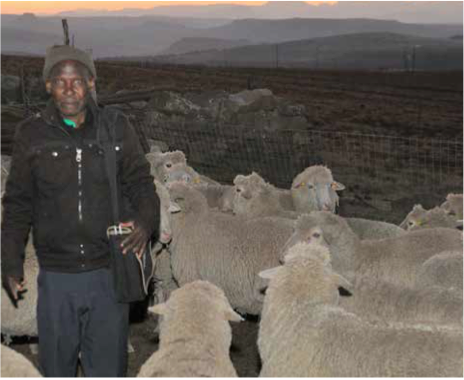The Masimenyane Wool Project in Engcobo village outside Mthatha produces 2000 wool bales from 5000 sheep and sells to local and international markets.
 Driving to Engcobo village, 80 kilo- meters outside Mthatha requires the driving skills of a Formula One driver and the patience of a saltwater crocodile.
Driving to Engcobo village, 80 kilo- meters outside Mthatha requires the driving skills of a Formula One driver and the patience of a saltwater crocodile.
The gravel road with its sharp curves, bends like a meandering river, taking you up the ridge, where man and sheep live in harmony.
This rocky terrain is home to the dohne merino sheep, which can be seen grazing in the rich vegetation around the village or laboriously making their way to the kraal. Even in the middle of winter, the sheep look well fed and adapted to the pastures and climate of the grassveld area.
It is these sheep that provide the raw material for the Masimenyane Wool Project, a local sheep-breeding cooperative.
The centre was started 15 years ago by 30 residents of the tiny village with the help from the Department of Rural Development and Agrarian Reform.
The centre was opened to breed sheep and forge close relations among the different families in the village. The department believed that the breeding centre could be used as a model project to encourage other sheep farmers in the province.
In 2008, with financial support from the department, the cooperative built a dipping tank, installed 75 rolls of barbed wire, bought sheep handling equipment, fenced off grazing lands, and ploughed sheep feed on nine hectares of land.
When they came together, the villagers didn’t know that they were bringing about a new chapter in their lives. They were just breeding sheep for keeping and for feeding their families. Little did they know that they could make money and support their families by selling fur from the sheep.
“We didn’t have an idea that we could sell the wool and make a living out of it,” recalls Mbijana Kotyi, Chairperson of the cooperative.
With 1800 sheep the cooperative had in 1998, they produced 30 bales, making R32 000 for members, says Kotyi.
Due to lack of equipment and space, the cooperative started off cutting the fur from the kraals. The cooperative now has a proper shearing shed, a facility for shearing wool.
In 2003, the cooperative started selling wool to people in and around the Chris Hani District Municipality. Their business expanded further, with assistance from BKB AgriFin, an agribusiness organisation which helped them to access overseas markets, mainly in Australia and China. “That’s when we could start sending wool to BKB in Port Elizabeth,” explains Kotyi.
In 2007, the cooperative partnered with a non-governmental organisation called Farmers Group, with Farmers Group offering to train members in cutting fur and managing the cooperative properly. According to Kotyi, the secret to the success of the project has been the good working relationship between the members and the involvement of young people has been instrumental as well.
Today, membership has grown to 114 with 5000 sheep producing 2000 wool bales and generating R268 000. A certain portion of the proceeds is set aside in a trust for members to send their kids to varsity, says Kotyi. With the commitment and energy of the members of the cooperative, the future looks bright and the Masimenyane Breeding Centre will grow from strength to strength.



 Facebook
Facebook Twitter
Twitter WhatsApp
WhatsApp